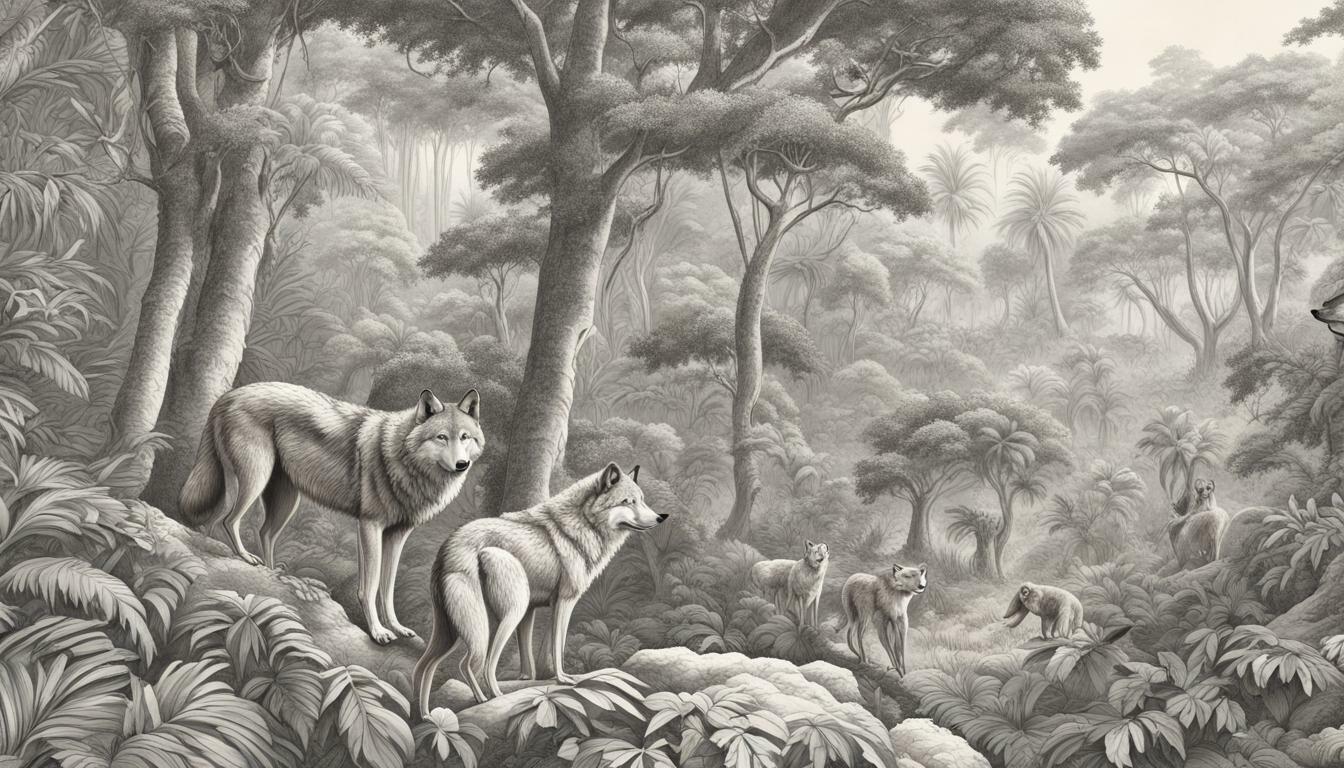Do Wolves Live In The Jungle? A Curious Wildlife Query

Table of content:
When you think of wolves, you might envision them roaming through snowy forests or across rugged mountains. But have you ever wondered if wolves live in the jungle? It’s a fascinating question that requires a closer look at these magnificent creatures and their habitat preferences.
Wolves are known for their adaptability, which allows them to thrive in a range of environments. However, when it comes to jungles, the answer is a bit more complicated than a simple yes or no.
Key Takeaways:
- Wolves are adaptable creatures that can survive in a variety of environments.
- Their habitat preferences are influenced by factors such as food availability, climate, and predator competition.
- While wolves are not typically found in dense jungle environments, they may occasionally venture into forested areas in search of prey.
Wolf Habitat Preferences
If you’ve ever wondered where wolves live, the answer is not as simple as “the jungle.” In fact, wolves have specific habitat preferences that suit their needs.
Wolves can be found in a variety of landscapes, including forests, grasslands, tundras, and deserts. They are most commonly associated with forested areas, but are also found in other environments where they can find prey and establish their territory.
Factors That Influence Wolf Habitat
Wolves require access to prey, water sources, and den sites in order to survive. They also need sufficient space to roam and establish their territory. The availability of these resources and the level of human disturbance in an area are important factors that influence wolf habitat preferences.
Wolves are also highly adaptable animals, capable of adjusting to changes in their environment and making use of new resources when necessary. For example, in some areas where their natural prey has been depleted, wolves have been known to hunt livestock or feed on carrion.
Preferred Habitat Characteristics
When it comes to their preferred habitat characteristics, wolves tend to favor areas with dense vegetation and ample cover, such as forests or brushy areas. This provides them with concealment for hunting and a safe place to rest during the day.
Wolves also prefer areas with water sources, such as lakes, rivers, or marshes. These provide an essential resource for drinking and can attract prey species to the area.
Overall, wolf habitat varies depending on the specific needs of the pack and the availability of resources in their chosen environment. While they may not live in the jungle, wolves can thrive in a range of habitats across the United States and around the world.
Wolf Behavior and Lifestyle
As social animals, wolves have a complex social structure within their packs. The pack usually consists of a dominant alpha pair that leads the group and their offspring, which are looked after by the other members of the pack. Each wolf has a specific role within the group, with some individuals being responsible for hunting, while others take care of the young.
Wolves communicate in different ways, including howling, vocalizations, and body language. They use their distinctive howl to communicate with other wolves within their pack and neighboring packs. Howling also helps wolves establish and maintain their territory.
When it comes to hunting, wolves have developed a sophisticated strategy that maximizes their chances of success. They often hunt in packs, cooperating with each other to bring down larger prey such as deer or elk. With their keen sense of smell and excellent tracking skills, wolves can follow a scent trail for miles.
Wolves are also highly adaptable animals, able to survive in a variety of different environments. However, they are best suited to living in areas where they can find sufficient prey and have enough space to establish their territory. Wolves in the wild typically live for six to eight years, although some have been known to live longer.
Wolf Diet and Hunting Strategies
Wolves are carnivores and primarily hunt large ungulates such as deer, moose, and elk. They are also known to prey on beavers, rabbits, and other small animals when larger prey is scarce. The pack works in coordination to take down a prey animal, often targeting the weakest or slowest member of the herd.
Alpha Wolves and Hunting Tactics
The alpha wolves, or leaders of the pack, usually take the lead during hunts. They are responsible for selecting the prey to target and coordinating the attack. The rest of the pack follows their lead and works together to take down the prey.
Wolves have developed several hunting strategies to make their hunts more successful. One of these strategies is called coursing, which is when wolves run after prey until it becomes exhausted. Another strategy is ambush hunting, in which the pack hides and waits for the prey to come closer before attacking.
Adaptations for Successful Hunting
Wolves have several adaptations that help them with successful hunting. One of those is their keen sense of smell, which is up to 100 times better than that of humans. They can detect prey from miles away and even differentiate between individual scents.
Wolves also have specialized teeth and jaws for tearing meat. Their sharp canines can puncture through tough hide and flesh, while their powerful jaws can crush large bones. Additionally, their muscular bodies and long legs allow them to run quickly and pursue prey over long distances.
- Wolves are carnivores and mainly hunt large ungulates.
- The alpha wolves lead during hunts, selecting prey and coordinating the attack.
- Wolves use different hunting tactics depending on the situation.
- Wolves have keen senses, specialized teeth and jaws, and muscular bodies adapted for successful hunting.
Wolves in the Wild
Wolves play a vital role in the natural environment as a top predator, helping to maintain the balance of the ecosystem. They are found in various regions of the world, including North America, Europe, and Asia.
Wolf packs typically consist of six to ten individuals, usually led by an alpha male and an alpha female. They communicate with each other through a wide range of sounds, including howls, growls, and barks.
Wolves are carnivores and feed on a variety of prey such as deer, elk, and small mammals. They have a unique hunting strategy where they work together as a pack to chase and exhaust their prey before making the final kill.
Wolves also have a strong sense of territory and will defend their boundaries against other packs and predators. The size of their territory depends on various factors, including the availability of prey and the density of other wolf packs in the area.
Despite their important role in the ecosystem, wolves face numerous threats to their survival, including habitat loss, human conflicts, and disease outbreaks. Conservation efforts, including the protection of their habitat and the implementation of sustainable hunting practices, are essential to ensure the continued existence of wolves in the wild.
Exploring Wolf Territories
Wolves are territorial animals that establish and defend their boundaries. Their territories can range from a few square miles to hundreds of square miles depending on the availability of resources and other factors.
Wolves mark their territories with scent markings, howling, and other communication methods to let other packs know that they are present. These markings also help them to find each other and to avoid potentially harmful interactions.
Factors That Shape Wolf Territory Size
The size of a wolf’s territory is largely determined by the availability of food. In areas with abundant prey, wolves may have smaller territories. In areas with fewer resources, wolf territories may be larger.
The size of a wolf pack also influences territory size. Smaller packs may have smaller territories, while larger packs may require more space to hunt and raise their young.
Interactions with Neighboring Packs
Wolves may have neighboring packs in close proximity to their territory. These interactions can range from friendly to aggressive. In some cases, neighboring packs may come together to hunt or to defend against a common threat. In other cases, there may be territorial disputes that can result in fights and even deaths.
Wolves have a complex social structure that allows them to live in harmony with each other and to work together as a pack. However, territorial disputes can occur when resources are scarce or when a new pack moves into an area.
Significance of Territory for Survival
Wolf territory is essential for their survival. It provides them with a home base where they can hunt, establish a den, and raise their young. Without a territory, wolves would have a difficult time finding food and shelter and would be more vulnerable to predators.
Wolves play a significant role in the ecosystem as top predators. Their territories help to maintain a balance in the ecosystem by controlling populations of prey animals and preventing overgrazing. Without wolves, the ecosystem would be at risk of becoming imbalanced.
Overall, exploring wolf territories is an essential part of understanding these fascinating animals. By learning about their habitat, behavior, and significance in the natural world, we can better appreciate and protect these magnificent creatures.
Conclusion
Now that you have learned about wolves, their habitat, behavior, and lifestyle, it is clear that they do not live in the jungle. Wolves prefer to live in colder regions, such as forests, tundra, and grasslands, where they have access to prey and can establish their territories.
Despite their reputation as fierce predators, wolves play an important role in the ecosystem. They help regulate the populations of prey species and maintain a balance in the food chain.
Exploring wolf territories is a fascinating topic, as it highlights their social structures, communication methods, and hunting strategies. By understanding their habits and preferences, we can appreciate their significance in the natural environment and work towards preserving their habitats.
Protecting Wolves in the Wild
Conservation efforts are crucial to ensure the survival of wolves in the wild. This includes protecting their habitats, regulating hunting practices, and reintroducing them to areas where they have been extinct. By working together, we can ensure that future generations can witness the beauty and strength of these magnificent creatures.
Welcome. I’m Adreena Shanum, the proud owner of this website, and I am incredibly passionate about animals, especially poultry. I founded adreenapets.com as a labor of love, stemming from my desire to share my knowledge and experiences with poultry enthusiasts worldwide.




